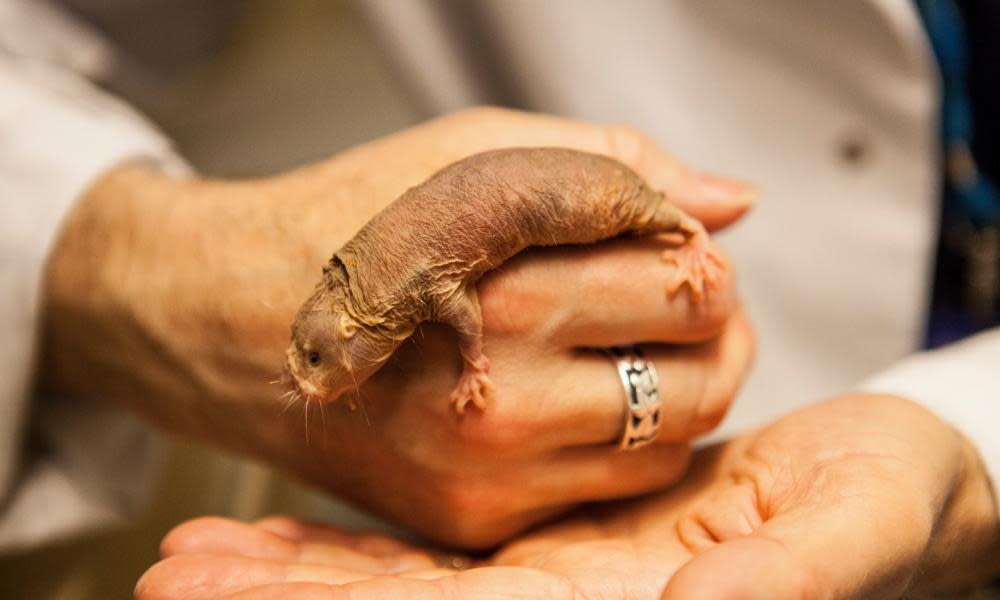New study of naked mole rats’ cancer resistance sparks row

With a hairless, wrinkly body, a whopping pair of front teeth and tiny eyes, the naked mole rat might seem an unusual creature to fight over, but a row has erupted among scientists over what might be its most unusual feature: a striking resistance to cancer.
The burrowing rodents, native to east Africa and described by one expert as resembling a sabre-toothed sausage, have long fascinated researchers.
Not only do they have surprisingly long lifespans, with some living for more than 30 years, but they do not feel certain kinds of pain and can survive for lengthy periods without oxygen, thanks to a system previously only found in plants.
They are also one of the only mammals known to live in highly organised, multigenerational colonies – a type of behaviour, known as eusociality, also seen in ants and bees.
But it is the rarity of cancer in naked mole rats that is at the heart of a new row. The dispute has its origins in a 2013 study by a US-led team who found that, unlike in mouse cells, when cancer-causing genes were introduced into naked mole rat cells, the cells did not turn cancerous.
However, researchers in Cambridge say that when they sought to harness the finding, they were shocked to find that the genetically altered naked mole rat cells not only grew on soft agar – a substance that only supports cancerous cells – but caused tumours when injected into mice.
“All of a sudden they were growing, in our hands, perfectly fine,” said Dr Walid Khaled, a cancer researcher at the University of Cambridge.
Writing in the journal Nature, Khaled and colleagues describe how their results held across 79 cell cultures grown from five types of tissue taken from 11 different naked mole rats.
To further check the results, the team carried out a host of tests, including using naked mole rat cells from the original US-led team.
Dr Ewan St John Smith, also from Cambridge University, said the results were “quite a dramatic difference” from the 2013 study. He said he and his colleagues were “paranoid” about checking their findings, but the results held. “These things can grow,” said Khaled.
The Cambridge team say their experiments suggest the 2013 study involved a problematic technique for selecting genetically altered cells, meaning many of the naked mole rat cells tested on soft agar did not contain the cancer-causing genes and hence, unsurprisingly, did not grow.
“It is like not putting [in] the major ingredient. Effectively the set-up is flawed,” said Khaled.
However, the US-led team have hit back, writing in Nature that the Cambridge researchers achieved different results because they introduced additional sections of DNA into the cells, which meant far higher levels of proteins were produced from the cancer-causing genes, overriding the naked mole rat’s natural cancer-resistance mechanisms.
“In nature we would not normally see such high levels of this gene expression,” said Prof Vera Gorbunova, of the University of Rochester.
Khaled said the Cambridge team’s results held even when they used the same DNA sections as the US-led group, and some of the latter’s latest experiments confirmed the findings.
Gorbunova agreed that her team’s new work showed cancerous naked mole rat cells could be produced in such circumstances, but said the effect was far smaller than for mouse cells. She said her team used naked mole rat cell cultures from the 2013 study in their new experiments, noting that they could have accumulated mutations over the years, explaining why they became cancerous.
The Cambridge team say their work suggests naked mole rat cells are no more intrinsically resistant to becoming cancerous than cells of other animals, and other factors must be behind the rarity of tumours in the rodents..
Smith said that among the possibilities, the neighbourhood around the cells may play an important role, as may the mole rats’ immune system.
Ultimately, he said, the new research was important for tackling cancer. “If we understand why mole rats don’t get cancer, that opens up doors for us understanding news ways of potentially preventing cancer occurring in humans.”

 Yahoo News
Yahoo News 
